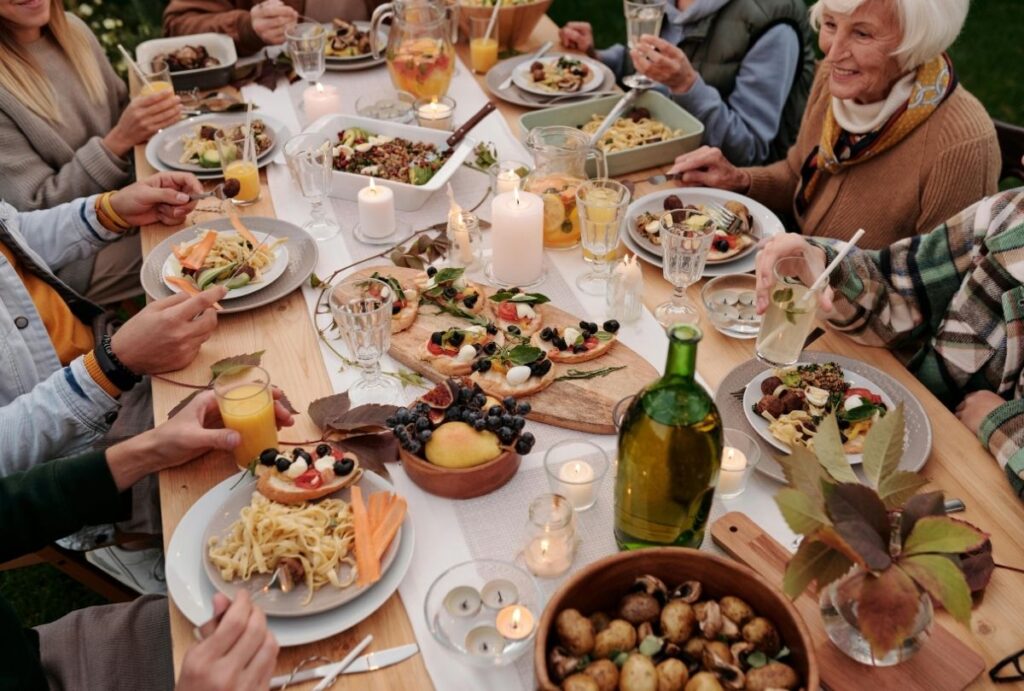This resource is part of our ‘Love what you eat‘ campaign for National Nutrition Week 2025.
This resource is part of our ‘Love what you eat‘ campaign for National Nutrition Week 2025.
one bite, one meal, one story at a time.
How we experience meals matters just as much as what’s on the plate. A calm, enjoyable setting can support healthier eating habits, encourage positive family communication, and even lower the risk of disordered eating in children (Fiese & Schwartz, 2008).
These ideas can help turn your table into a space that supports comfort, connection, and joy.
Create a welcoming table with small, thoughtful touches that invite connection and take the pressure off mealtimes.
Tips for creating a comfortable and connected table:
Activity Prompt:
Pick one idea from the list above and bring it to life at your next meal. Reflect on how it changes the experience.
Letting people serve themselves can boost awareness of portion sizes, encourage autonomy, and build mindful eating habits. (Robinson et al., 2014) For children, this independence helps them learn to trust hunger cues, increases willingness to try new foods, and reduces risk of disordered eating. (Birch & Fisher, 1998, DiSantis et al., 2011)
Activity prompt:
Try family-style dining: place dishes in the center of the table and let everyone serve themselves. Encourage kids to choose what they’d like and tune into their hunger and fullness cues.
Eating mindfully is about slowing down and appreciating food in a way that supports both nourishment and enjoyment. Mindful eating practices have been linked to healthier eating behaviours, better self-regulation around hunger and fullness, and a more positive relationship with food (Mason et al., 2016).
When we eat with awareness, we give ourselves the chance to enjoy meals more fully and respond to what our body needs, rather than eating on autopilot. This simple shift can reduce overeating, support healthy weight regulation, and make food more satisfying.
Mindful Eating – Eating Disorders Victoria
This short factsheet by Eating Disorders Victoria covers the benefits of mindful eating, additional information about how to practice mindful eating, and a range of helpful activities and resources.
Headspace has a 7-day plan to guide you through staying present at mealtimes.
Mealtimes are about more than food, they’re an opportunity for intentional conversation that helps everyone feel heard, valued, and included. Research shows that family meals are associated with stronger self-esteem, improved academic outcomes, and reduced risk of substance use in children and teens (Hammons & Fiese, 2011).
Explore these simple ways to strengthen connections and conversation at the table.
Use mealtimes as an opportunity to start meaningful conversations.
Ask open-ended questions: Invite stories, imagination, and reflection. For example: “What’s something that made you smile today?”
Practice active listening: Put away distractions, make eye contact, and show genuine curiosity.
Include every voice: Encourage everyone, including kids, to join in not just during the meal, but in planning too.
Activity prompt:
Download our conversation starter cards (or create your own). Pick one question at each meal this week to help make mealtimes more connected and fun.
Mealtimes don’t have to end when the plates are empty. Wrapping up together can make the experience even more positive and meaningful.
Here are some simple ways to finish a meal together that leave everyone feeling positive and connected.
Post-meal routines can reinforce positive mealtime experiences and support shared responsibility.
Make clean-up a shared moment: Turn on a song and tidy up as a team.
Reflect together: Talk about what everyone enjoyed most and what you’d love to try next time.
Savor the memory: Take a photo of a meal you loved and journal why it felt good, whether it’s the flavours, the company or the conversation.
Activity prompt:
Thank the cook! Have everyone share one thing they appreciated about the meal or the effort behind it.
Cauliflower dahl with pilaf rice
This warm and cosy dish is the perfect centrepiece for family style dining. Simple and delicious that the whole family can enjoy.
Fruit salads add colour to a table and can bring joy to family style gatherings. Get creative with how you style the fruit and using seasonal produce means you can bring this platter year-round. Perfect for when you need to bring a dish.
Explore more useful resources.


